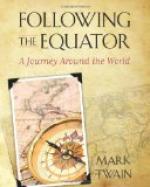“At length the smallest of them made an infantile attempt to get away. The little thing had been frightened past bearing by the murder of one of the surviving ladies. He thus attracted the observation of a native who flung him and his companions down the well.”
The soldiers had made a march of eighteen days, almost without rest, to save the women and the children, and now they were too late—all were dead and the assassin had flown. What happened then, Trevelyan hesitated to put into words. “Of what took place, the less said is the better.”
Then he continues:
“But there was a spectacle to witness which might excuse much. Those who, straight from the contested field, wandered sobbing through the rooms of the ladies’ house, saw what it were well could the outraged earth have straightway hidden. The inner apartment was ankle-deep in blood. The plaster was scored with sword-cuts; not high up as where men have fought, but low down, and about the corners, as if a creature had crouched to avoid the blow. Strips of dresses, vainly tied around the handles of the doors, signified the contrivance to which feminine despair had resorted as a means of keeping out the murderers. Broken combs were there, and the frills of children’s trousers, and torn cuffs and pinafores, and little round hats, and one or two shoes with burst latchets, and one or two daguerreotype cases with cracked glasses. An officer picked up a few curls, preserved in a bit of cardboard, and marked ’Ned’s hair, with love’; but around were strewn locks, some near a yard in length, dissevered, not as a keepsake, by quite other scissors.”
The battle of Waterloo was fought on the 18th of June, 1815. I do not state this fact as a reminder to the reader, but as news to him. For a forgotten fact is news when it comes again. Writers of books have the fashion of whizzing by vast and renowned historical events with the remark, “The details of this tremendous episode are too familiar to the reader to need repeating here.” They know that that is not true. It is a low kind of flattery. They know that the reader has forgotten every detail of it, and that nothing of the tremendous event is left in his mind but a vague and formless luminous smudge. Aside from the desire to flatter the




